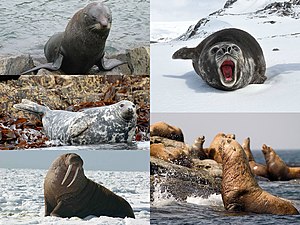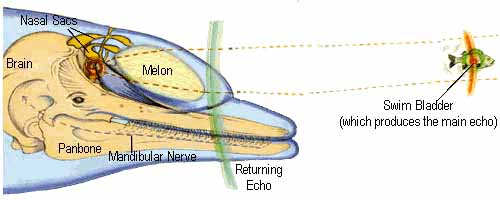Anyway.
Marine Mammals.

Screw you.
A mammal is a higher vertebrate with a well-developed brain and neural system. It is warm-blooded with homeostatic control in order to ensure a maintained core body temperature. They give birth to live young and feed this young through mammary glands. They breathe air and contain epidermis with hair. Marine mammals must be able to swim and dive to great depths in many instances; be able to control their body temperature as they are doing so, all the while often supporting offspring.
Marine mammal taxonomy
- Pinnipeds - seals, fur seals and walruses. There are 33 species of pinnipeds, and they all have an amazing ability to dive up to depths of 1500 feet, and can hold their breath for 2 hours straight. The Caribbean Monk Seal was hunted to extinction in 1952 - humans love(d) them.
 Seals have an internal ear with no external features, just a closeable hole; they have clawed front flippers, whcih are all they walk with, and they swim with their hind flippers. They are mainly polar animals, and the arctic seals haver a wide range of threats including commercial fishing, pollution, and other predators. Antarctic seals have reduced problems with predation, pollution and fishing however, under the CCAS (Convention for the Conservation of Antarctic Seals). They control temperature with blubber and blood circulation, the former being rich in fatty oils to insulate and provide a rich energy source, the latter constrict to reduce periphery blood supply. They have a high oxygen store in blood and body tissues, 4x that of a human athlete, and bradychardia - the slowing of the heart whilst blood pressure is maintained, and this is all to facilitate diving. Usually each mature female will have one pup per year, give birth on land, and feed the pup with milk that is up to 50% fat. A dominant male will have a hareem of females. Arctic seals feed upon cod, shrimps and squid; bearded seals feed upon shrimps, crabs, clams and whelks; Antarctic seals meanwhile almost solely feed upon Krill.
Seals have an internal ear with no external features, just a closeable hole; they have clawed front flippers, whcih are all they walk with, and they swim with their hind flippers. They are mainly polar animals, and the arctic seals haver a wide range of threats including commercial fishing, pollution, and other predators. Antarctic seals have reduced problems with predation, pollution and fishing however, under the CCAS (Convention for the Conservation of Antarctic Seals). They control temperature with blubber and blood circulation, the former being rich in fatty oils to insulate and provide a rich energy source, the latter constrict to reduce periphery blood supply. They have a high oxygen store in blood and body tissues, 4x that of a human athlete, and bradychardia - the slowing of the heart whilst blood pressure is maintained, and this is all to facilitate diving. Usually each mature female will have one pup per year, give birth on land, and feed the pup with milk that is up to 50% fat. A dominant male will have a hareem of females. Arctic seals feed upon cod, shrimps and squid; bearded seals feed upon shrimps, crabs, clams and whelks; Antarctic seals meanwhile almost solely feed upon Krill.
Phoca hispida - Ringed seal: digs holes in the ice sheat up to 7ft thick, offspring weaned in 2 months.
Erignathus barbalus - Bearded seal: Head-rams the ice to make holes, pups can dive 200ft after 1 month, weaned in 3 weeks.
Lobodon carcinophagus - Crabeater seal: don't eat crabs but have ridged teeth to filter krill.
Hydrurga leptonyx - Leopard seal: top predator up to 12ft long, weaned after 3-4 months.
Phoca vitulina - Harbour seal
Phoca caspica - Caspian seal
Fur seals and sea lions have ears that extend out from the head, use their longer front flippers for swimming and rear flippers for walking. They're found in the N. Pacific, Australia and New Zealand. Sea lions (Otariidae) include:
Eumetopius jubalus - Stellers Sea lion
Neophoca cinerea - Australian sea lion
Fur seals (Actocephalinae) include:
Callaorhirinus ursinus - Northern Fur Seal
South African and Guadalupe Fur Seals
 80% of the Pacific Walrus (Odebenus rosmarus) population reside in the Bering sea in the winter, but females and immatures move north in to the Chuckchi Sea in the spring, whilst males migrate south. Their principle food is clams.
80% of the Pacific Walrus (Odebenus rosmarus) population reside in the Bering sea in the winter, but females and immatures move north in to the Chuckchi Sea in the spring, whilst males migrate south. Their principle food is clams.- Carnivora - polar bear and sea otter: Polar bears (Ursus maritimus) are distributed circumpolar around the ice pack, mainly on landfast ice and floe edges. They have no natural predators and are controlled by the abundance of prey, and the hunting of man. Sea Otters (Enhydra lutris) weigh the same as Kylie Minogue - 45kg, and have the thickest fur in the animal kingdom. They sleep in the water and roll up in kelp at the surface to prevent drifting off. They are a keystone predator to maintain the kelp system free of over-grazing by urchins, but also feed off of mussels, clams and abalone. They are threatened chiefly by habitat loss, oil spills, pollution and hunting.

- Sirenians - manatees and dugong: vegetarians that may eat up to 15kg of sea-grass a day, and are found in salt, fresh and brackish waters. They are solitary animals, the mother-calf being the only social bond. The gestation period is one year, therefore reproduction rate is quite low, females giving birth every 2-5 years. Chief threats include habitat loss and boat collisions.

Trichechus manatus - West Indian manatee
Trichechus senegalensis - West African manatee
Trichechus inunguis - Amazonian manatee
Dugong dugon - Dugong
- Cetaceans - whales and dolphins.
Whales may be split up in to the Mysticeti and Odontoceti - baleen and toothed. The Mysticeti whales have no teeth, but keratin baleen plates suspended from the roof of the mouth, alongside two nasal openings in a symmetrical skull. They have no echolocation capabilities, with the melon only being present in the foetal stage. Odontoceti have teeth - up to 250 in some dolphin species, and a single nasal opening in an asymmetrical skull. The melon is well-developed and plays a major role in echolocation. Their taxonomy is constantly under review, based on genetic analysis of their ribosomal RNA sequences, which has suggested Odontocetes, Sperm Whales, may be more closely related to the Mysticetes.

Blue Whale vocalisation is composed of trills and moans, called A-calls and B-calls. They have a very low frequency of 10-39Hz, nothing humans can hear. Megaptera novaeangliae (Humpback Whales) range from 30 Hz - 8 KHz, using moans, grunts, blasts and shrieks. In Mysticetes, air is moved from the lungs, and the nasal/larangeal sacs act as resonators. In Odontocetes, it is less well understood, but sound is produced by two pairs of phonic lips in nasal passages, not the larynx. The phonic lips are connected to the dorsal bursa, organs which vibrate when air passes through the lips. Most species have two sets of phonic lips and dorsal bursa. Sperm whales and other Odontocetes use a similar method but have Spermacetti instead of dorsal bursa.
The melon structure found in the forehead of Odontocetes focuses sound waves, since water is denser than air, so sound waves travel 5x faster. They detect reflected waves through the mandibular nerve, transmitting the signals to the brain.
Ocean waters are stratified due to surface warming by long-wave thermal radiation, forming distinct layers around the thermocline. The buffer zone of the metalimnion just below the thermocline is ideal to transmit sound waves slowly over longer distances, because due to refraction, the sound waves are entrained in the buffer zone and transmitted horizontally in all directions. Whales take advantage of this in breeding season.
Echolocation and Vocalisation
There is discussion as to whether echolocation/vocalisation is communication in the form of language, or akin to that of bird song. The clicks and whistles of dolphins (echolocation and communication) have distinct signatures, and dolphins can imitate the whistles of others to attract their attention. In captivity, dolphins will imitate the human voice so well local accents can be detected. Male dolphins are better at imitating and have a signature close to its mother; females are more distinctive, owing to the social grouping, where females remain in the pod. It is much the same for Sperm Whales. Whale song typically lasts 20 minutes or longer, and is then repeated. It may be changed completely between breeding seasons, potentially to increase the attraction of females - maybe the last song just didn't cut it!!
Blue Whale vocalisation is composed of trills and moans, called A-calls and B-calls. They have a very low frequency of 10-39Hz, nothing humans can hear. Megaptera novaeangliae (Humpback Whales) range from 30 Hz - 8 KHz, using moans, grunts, blasts and shrieks. In Mysticetes, air is moved from the lungs, and the nasal/larangeal sacs act as resonators. In Odontocetes, it is less well understood, but sound is produced by two pairs of phonic lips in nasal passages, not the larynx. The phonic lips are connected to the dorsal bursa, organs which vibrate when air passes through the lips. Most species have two sets of phonic lips and dorsal bursa. Sperm whales and other Odontocetes use a similar method but have Spermacetti instead of dorsal bursa.
The melon structure found in the forehead of Odontocetes focuses sound waves, since water is denser than air, so sound waves travel 5x faster. They detect reflected waves through the mandibular nerve, transmitting the signals to the brain.
Ocean waters are stratified due to surface warming by long-wave thermal radiation, forming distinct layers around the thermocline. The buffer zone of the metalimnion just below the thermocline is ideal to transmit sound waves slowly over longer distances, because due to refraction, the sound waves are entrained in the buffer zone and transmitted horizontally in all directions. Whales take advantage of this in breeding season.
Ecology and adaptations of Cetaceans
They have an aquatic lifestyle, feeding mating and giving birth in the water. They have complex hunting and feeding methods, with vocalisation including echolocation, and a complex community structure. Only Baleen whales are solitary but can form feeding groups, if only for a few hours. Methods of feeding include bubble nets, used by Humpback Whales; kerplunking by Bottlenose Dolphins, and listening by Killer Whales.
Mysticetes: Feeding and prey
Mysticetes are batch feeders, that gulp and create a suction in the rear part of their mouths to draw in water; this the Grey Whale and Blue Whale does. They also skim a continuous flow of water through their mouths, such as the Pygmy Right Whale and Bowhead Whale. Mysticetes feed upon krill and other zooplankton, alongside cephalopods and fish.
Mysticetes: Feeding and prey
Odonticetes are raptorial, grabbing their prey with rapid swimming motions, but they also use oral or larangeal expansion to draw in prey. The Delphinidae feed upon cephalopods; Phocenidae feed upon cephalopods and fish; Ziphiidae feed upon cephalopods; Monodonticidae feed upon fish, cephalopods and benthic invertebrates.
Threats
- By-catch from fisheries; porpoises and dolphins in particular are threatened by this.
- Food competition between dolphins and porpoises
- Cetacean Decompression Sickness, which is linked to active sonar blasts that interfere with their orientation and communication.
- Phocine Distemper Virus, amongst other diseases.
No comments:
Post a Comment